Table Of Content
- Introduction
- Choose a Green Campsite Location
- Utilize Sustainable Camping Gear
- Minimize Single-Use Items
- Implement Proper Waste Management
- Organize Your Camp Kitchen Effectively
- Set Up a Recycling Station
- Create a Compost System
- Choose a Green Campsite Location
- Consider the following tips for choosing a sustainable campsite
- Utilize Sustainable Camping Gear
- Invest in Durable, Eco-Friendly Equipment
- Consider the Lifecycle of Your Gear
- Minimize Single-Use Items
- Why Should We Minimize Single-Use Items?
- How Can We Minimize Single-Use Items?
- The Impact of Reducing Single-Use Items
- Implement Proper Waste Management
- Carry reusable containers and bags.
- Sort your waste
- Organize Your Camp Kitchen Effectively
- Streamline Your Camp Kitchen Setup
- Choose Sustainable Cookware and Utensils
- Practice Mindful Meal Planning
- Set Up a Recycling Station
- Create a Compost System
- Why Compost?
- How to Set Up a Compost System
- The Benefits of Composting
- Reduce Energy Consumption
- Utilize Natural Light and Solar Power
- Opt for Rechargeable Batteries
- Limit the Use of Gas-Powered Equipment
- Unplug Unused Electronics
- Opt for Eco-Friendly Hygiene Products
- Why Should You Choose Eco-Friendly Hygiene Products?
- What Are Some Eco-Friendly Hygiene Product Options?
- How Can Eco-Friendly Hygiene Products Enhance Your Camping Experience?
- Leave No Trace Principles
- What are the Leave No Trace Principles?
- How can you incorporate the Leave No Trace Principles into your camping trip?
- Why are the Leave No Trace Principles important for sustainable outdoor living?
- Frequently Asked Questions (FAQs)
- What is an eco-friendly campsite organization?
- How can I practice sustainable camping at my campsite?
- What are some eco-friendly campsite organization tips?
- Why is it essential to organize a campsite sustainably?
- How can I reduce waste while camping?
- What are some sustainable practices for outdoor living?
Welcome to the world of Eco-Friendly Campsite Organization and Sustainable Outdoor Living! As an experienced outdoor enthusiast, I am thrilled to share the essential tips and practices to create an environmentally conscious camp setup that promotes harmony with nature.
When venturing into the great outdoors, minimizing our ecological footprint and respecting the natural surroundings that provide us with so much beauty and tranquility is crucial. By adopting sustainable practices and implementing efficient organization techniques, we can ensure that our camping experiences benefit us and contribute to the preservation of our planet for future generations.
From selecting eco-friendly camping gear to practicing Leave No Trace principles, there are numerous ways to make your campsite more environmentally friendly. By incorporating these strategies into your outdoor adventures, you can enjoy a deeper connection with nature while reducing waste and promoting conservation efforts.
Join me on this journey towards creating a more sustainable and eco-conscious camping experience. Let’s explore the endless possibilities of Eco-Friendly Campsite Organization and embrace the beauty of Sustainable Outdoor Living as we immerse ourselves in the wonders of the natural world.
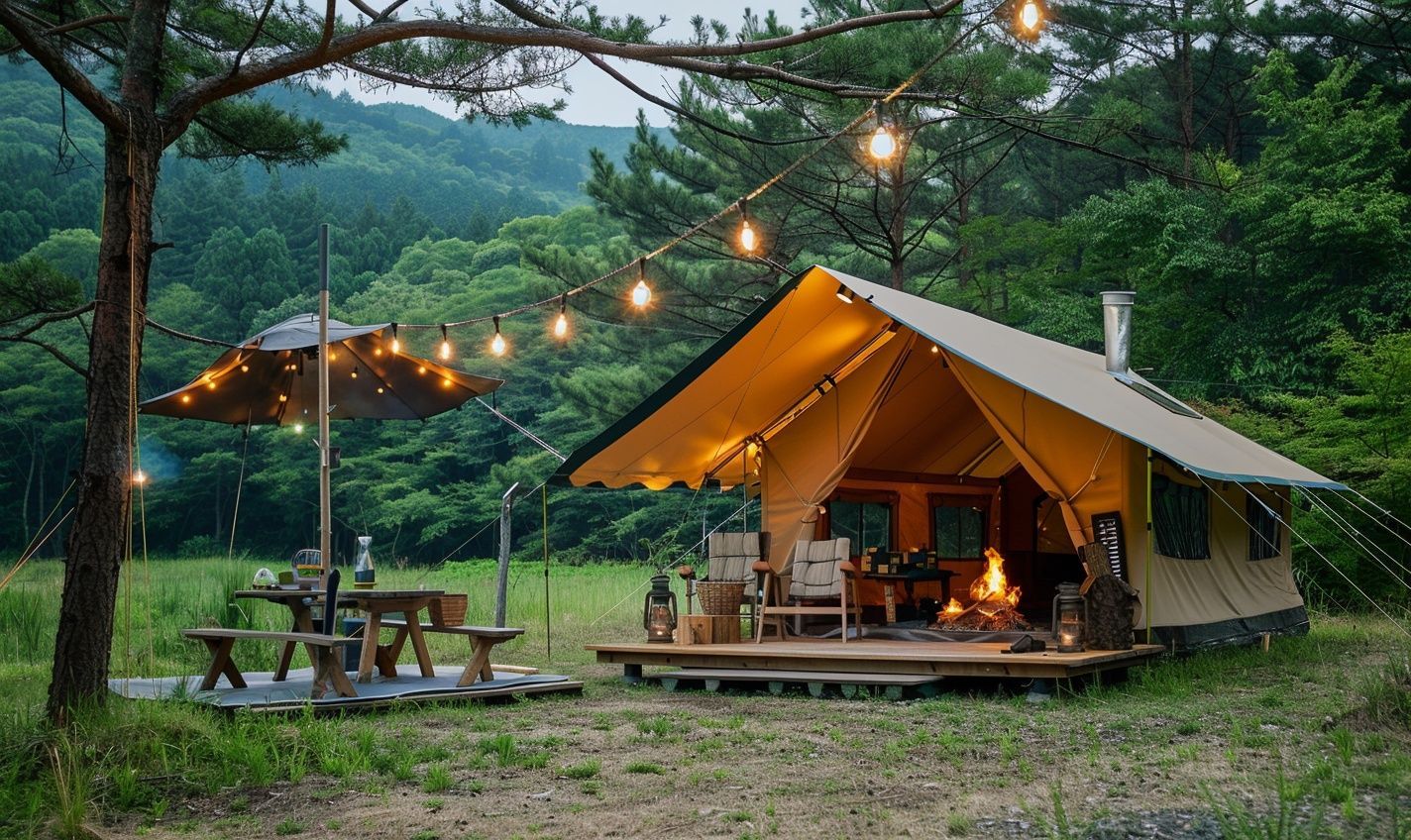
Introduction
Welcome, fellow nature lovers! As we immerse ourselves in the great outdoors, it’s crucial to ensure we leave eco-friendly campsite organization and sustainable practices in our wake. By adopting green habits and mindful camping techniques, we can minimize our environmental impact and truly embrace the beauty of outdoor living.
Choose a Green Campsite Location
When setting up camp, opt for a site that has already been used to minimize disturbances to new areas. Remember, every step we take can leave a footprint on the delicate balance of nature.
Utilize Sustainable Camping Gear
Invest in gear made from recycled materials or renewable resources. Equipping ourselves with durable, high-quality items reduces the need for constant replacements, thus lessening waste production.
Minimize Single-Use Items
Swap out disposable products for reusable alternatives. Every small change contributes to a more sustainable camping experience, from cutlery and plates to water bottles and bags.
And isn’t it satisfying to know you’re reducing your ecological impact with each reusable item you use?
Implement Proper Waste Management
Sort your waste into separate recycling, composting, and general garbage bins. Keeping a tidy campsite benefits the environment and creates a more pleasant living space for everyone.
- Recycling
- Composting
- General Waste
Organize Your Camp Kitchen Effectively
Arrange your cooking and food supplies efficiently to minimize food waste and streamline meal preparation. Being organized not only saves time but also conserves resources.
And remember, a well-prepared camp kitchen can be the heart of your outdoor living experience.
Set Up a Recycling Station
Dedicate a specific area in your campsite to recycling bins to encourage proper disposal of recyclable materials. This will make it convenient for everyone to do their part in reducing waste.
Create a Compost System
Start a compost pile for organic waste, such as food scraps and biodegradable items. Transforming waste into nutrient-rich soil benefits your campsite and the environment.
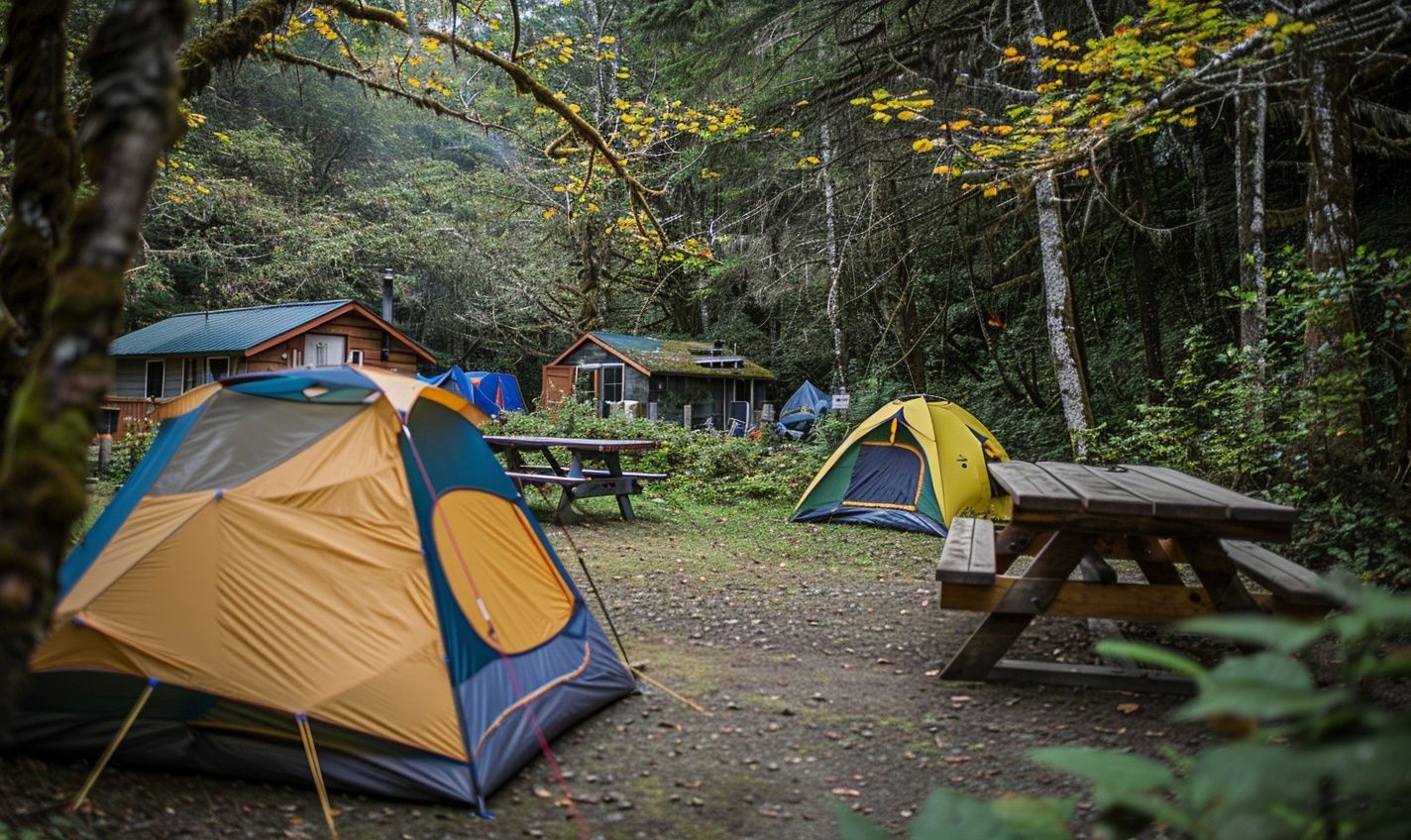
Choose a Green Campsite Location
When embarking on your outdoor adventure, the first step in creating an eco-friendly campsite is choosing the correct location. By selecting a green campsite location, you can minimize your environmental impact and enjoy nature’s beauty responsibly.
Consider the following tips for choosing a sustainable campsite:
1. Opt for established campsites: Utilize designated camping areas with established fire pits and restroom facilities to reduce your impact on the surroundings and preserve the natural habitat.
2. Choose campsites near water sources: Camping near rivers or lakes provides picturesque views and encourages responsible water usage for drinking, cooking, and cleaning.
3. Check local regulations: Before setting up camp, familiarize yourself with any rules or restrictions to ensure you follow sustainable practices and protect the environment.
4. Avoid delicate ecosystems: Avoid fragile ecosystems such as wetlands, meadows, or alpine zones to prevent the disruption of wildlife habitats and sensitive plant species.
5. Spread out your campsite: Disperse your tent, cooking area, and waste disposal sites to minimize concentrated impact on the land and allow vegetation to recover more quickly.
6. Leave no trace: Always abide by the Leave No Trace principles by packing out all waste, leaving natural objects undisturbed, and respecting wildlife to maintain the integrity of the campsite.
Remember, the choices you make when selecting a campsite can have a lasting impact on the environment. By consciously choosing a green campsite location, you can practice sustainable camping and contribute to preserving our outdoor spaces for future generations to enjoy.
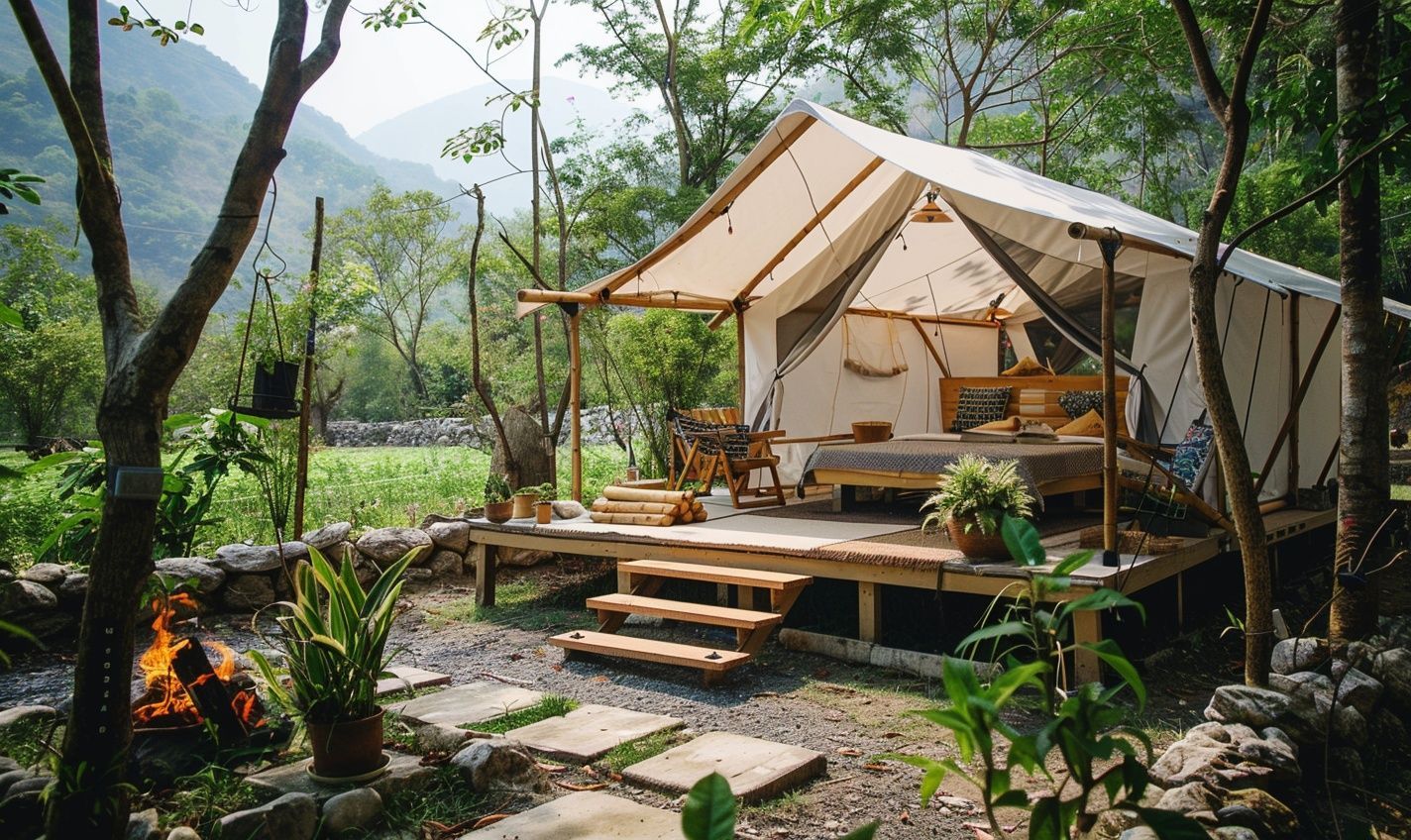
Utilize Sustainable Camping Gear
Sustainable camping gear is crucial to campsite organization and setting up an eco-friendly outdoor living space. By incorporating environmentally friendly products into your camping setup, you reduce your carbon footprint and preserve nature’s beauty for future generations.
Invest in Durable, Eco-Friendly Equipment
Choosing durable, sustainable camping gear ensures you’re not constantly replacing items, creating less waste in the long run. Opt for products made from recycled materials or those that are easily renewable.
Consider the Lifecycle of Your Gear
Think about what happens to your camping gear when it expires. Select items that are biodegradable or can be easily recycled or upcycled. This will minimize your impact on the environment.
When setting up your campsite, remember that sustainable practices can extend to all aspects of your outdoor living experience. By organizing your gear mindfully and making eco-conscious choices, you can enjoy the beauty of nature while minimizing your footprint.
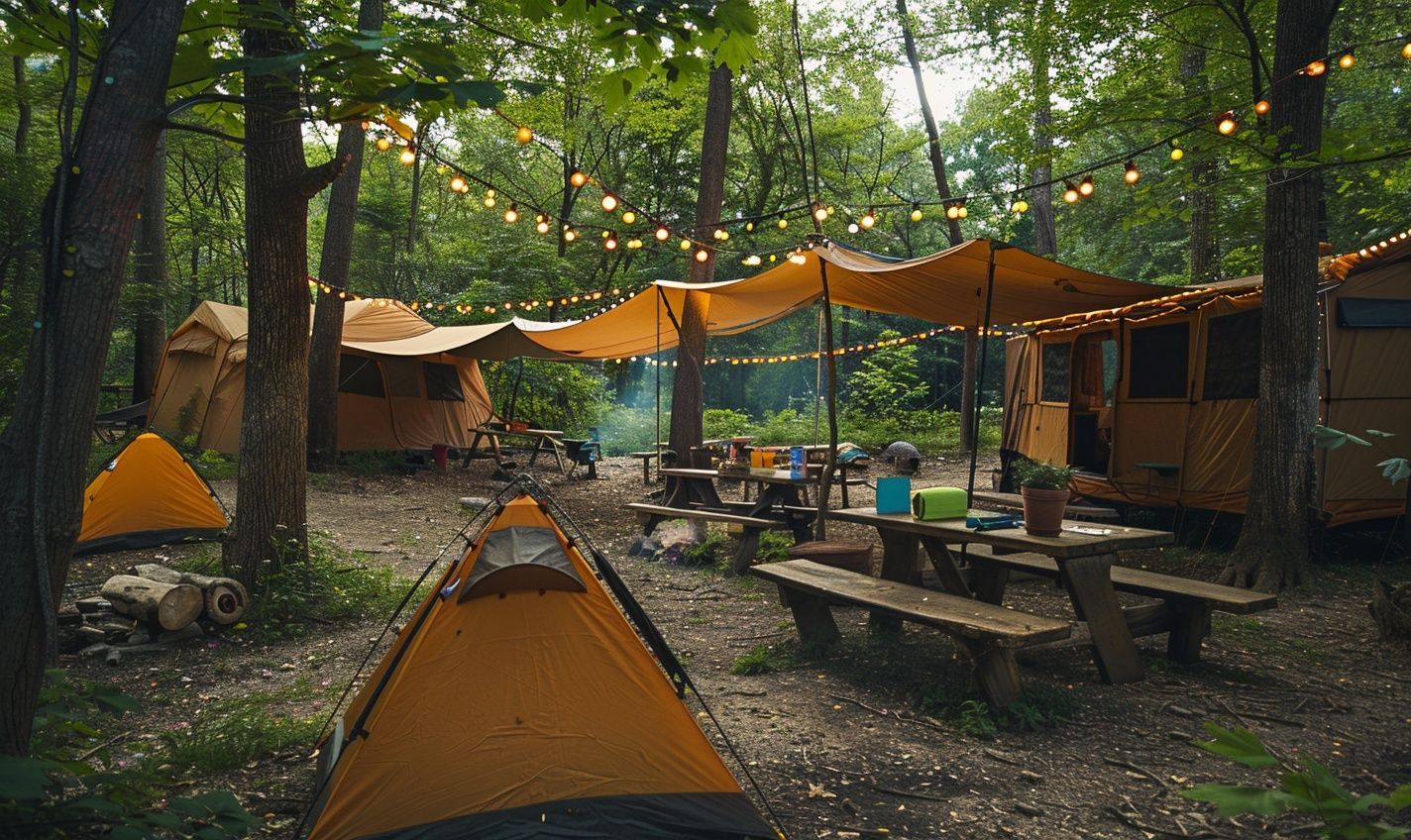
Minimize Single-Use Items
When preparing for a camping trip, we must consider our actions’ environmental impact on the beautiful outdoor spaces we cherish. Minimizing single-use items at campsites is one significant way to reduce our ecological footprint.
Why Should We Minimize Single-Use Items?
The convenience of disposable products often comes at a high environmental cost. Consider the plastic waste that litter our campsites and endangers wildlife. Do we want our temporary stay in nature to leave a lasting negative impact?
How Can We Minimize Single-Use Items?
- Invest in durable, reusable alternatives (metal utensils, bamboo plates).
- Opt for refillable containers for water, condiments, and toiletries.
- Choose multi-purpose items to reduce the need for single-use products.
The Impact of Reducing Single-Use Items
Picture a campsite free of plastic wrappers and disposable bottles strewn across the ground. By embracing sustainable practices and minimizing single-use items, we pave the way for a cleaner, more eco-friendly outdoor experience. Our collective efforts can inspire others to follow suit, creating a ripple effect of positive change in our outdoor living habits.
By making simple swaps and conscious choices, we can transform our campsites into models of eco-responsibility. Let’s strive to minimize waste and leave a positive impact on the environment, ensuring that the beauty of nature remains preserved for future generations to enjoy.
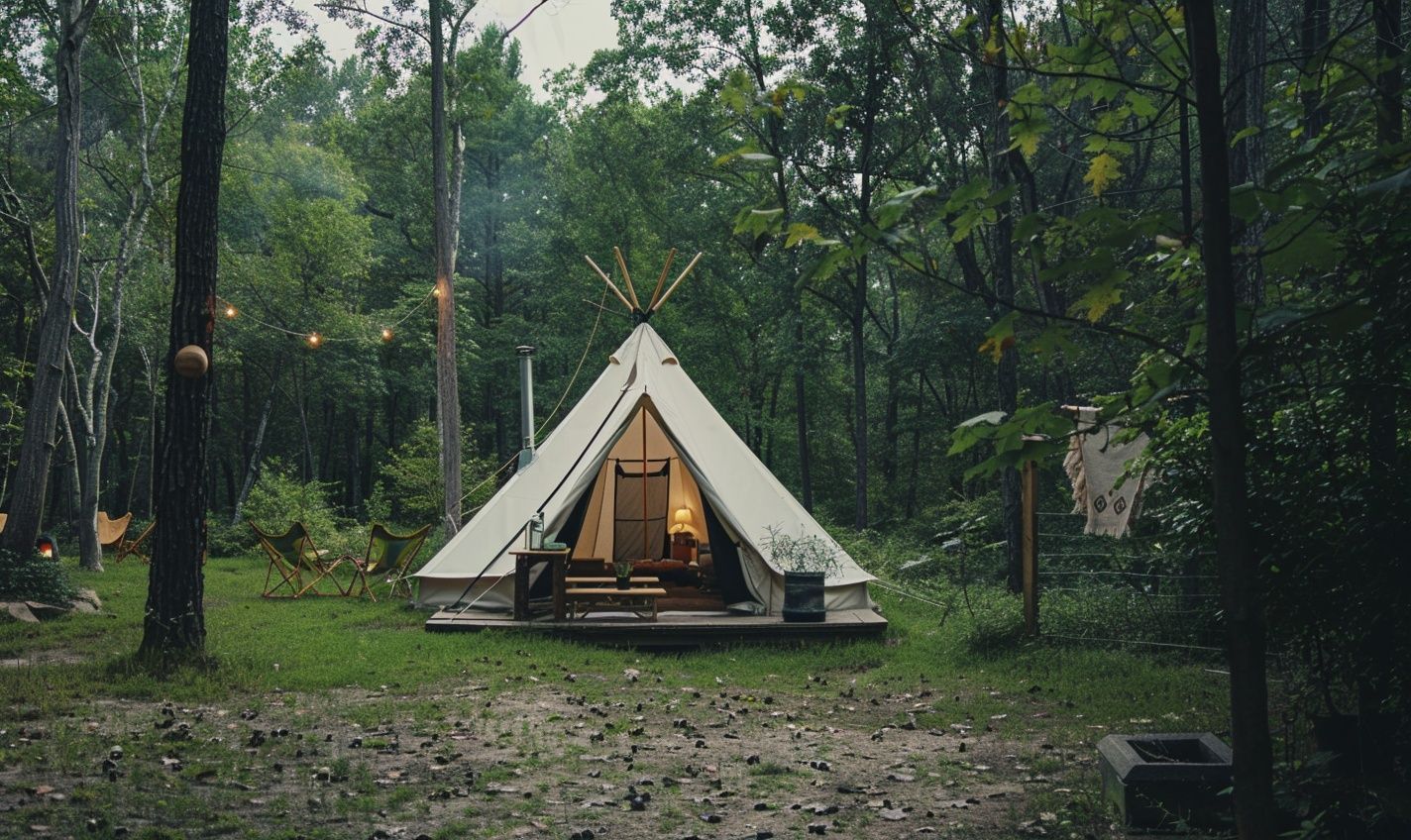
Implement Proper Waste Management
Proper waste management is critical to creating an eco-friendly campsite. Just as we clean up after ourselves at home, we should also practice good waste habits in the great outdoors. By following some simple steps and using sustainable practices, you can ensure your camping experience is enjoyable and leaves minimal impact on the environment.
Carry reusable containers and bags.
- Reduce waste by using reusable containers for food storage
- Bring along a durable, washable bag for collecting any trash
- Opt for reusable utensils and dishware to minimize single-use items
Sort your waste
- Separate recyclables from trash to make recycling easier
- Dispose of organic waste like food scraps in a designated compost area
- Properly dispose of hazardous items like batteries to prevent environmental harm
By taking these steps, you can reduce the waste generated at your campsite and make it easier to practice sustainable camping. Think of waste management as your way of giving back to nature, ensuring that the beauty of the outdoors remains untarnished for future generations to enjoy.
And remember, just like any other aspect of camping, waste management is a skill that improves with practice. The more you consciously try to reduce, reuse, and recycle, the more it’ll become second nature. You’ll feel a sense of accomplishment knowing that your campsite is organized and clutter-free, leaving only positive memories and a minimal footprint behind.
So, as you embark on your next outdoor adventure, remember the importance of waste management. By implementing these sustainable practices, you’ll enhance your outdoor living experience and preserve the natural beauty of our planet for generations to come.
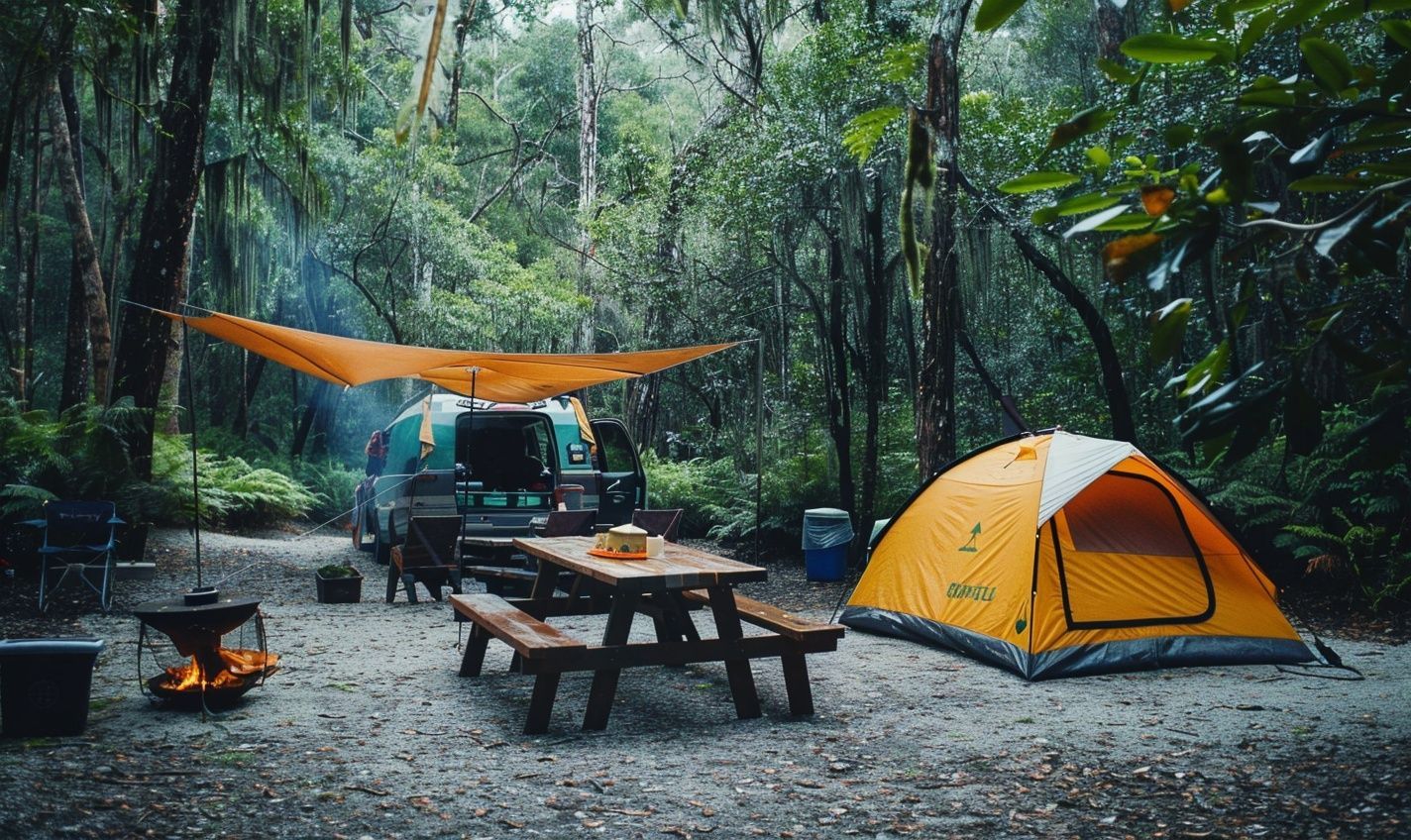
Organize Your Camp Kitchen Effectively
Camping is not just about disconnecting from the modern world and reconnecting with nature; it’s also an opportunity to practice eco-friendly campsite organization and sustainable living practices. When it comes to outdoor living, setting up your camp kitchen efficiently can significantly impact you.
Streamline Your Camp Kitchen Setup
And that doesn’t mean sacrificing convenience for sustainability. You can enjoy delicious meals by organizing your camp kitchen effectively while minimizing your environmental footprint.
Start by creating designated areas for cooking, food storage, and washing up. Use natural landmarks as boundaries to define these zones.
- Designate a cooking area away from your tent to prevent food smells from attracting wildlife.
- Store food in sealable containers to prevent waste and keep critters away.
- Set up a washing station with biodegradable soap and water collected from a nearby stream or lake.
Choose Sustainable Cookware and Utensils
Invest in quality, durable, sustainable camping gear that will last years. Look for reusable, multi-functional items that serve multiple purposes and reduce the need for disposable alternatives.
- Bring along a set of reusable utensils and plates instead of single-use plastic.
- Opt for a collapsible silicone sink for easy dishwashing and water conservation.
- Consider using a camp stove powered by eco-friendly fuel sources such as propane or ethanol.
Practice Mindful Meal Planning
Planning your meals can reduce food waste and minimize the resources needed to prepare and cook food.
Pack items that can be used in multiple dishes to streamline your cooking process and reduce excess packaging.
- Prep ingredients at home to minimize the need for extra tools and utensils at the campsite.
- Opt for local and organic produce to support sustainable farming practices and reduce your carbon footprint.
Set Up a Recycling Station
And now, let’s dive into one of the essential aspects of creating an eco-friendly campsite: Set Up a Recycling Station.
Why is it crucial to have a recycling station at your campsite?
- Creates a visual reminder to practice sustainable habits
- Reduces the risk of littering and promotes a clean environment
How can you effectively set up a recycling station?
1. Designate Specific Bins: To streamline the recycling process, use separate containers for plastics, paper, glass, and metal.
2. Label Each Bin: Clear labeling helps campers understand what items go where, ensuring proper recycling.
3. Educate Fellow Campers: Spread awareness about the importance of recycling and provide guidance on sorting waste correctly.
By setting up a recycling station, you’re managing waste and contributing to a healthier planet. Remember, every piece of recycled trash is one less piece polluting our beautiful outdoors.
But your eco-friendly campsite organization doesn’t stop there; it extends to creating a sustainable environment holistically.
Sustainable Practices for Outdoor Living
To minimize waste, reuse reusable items like water bottles, utensils, and containers.
Opt for solar-powered gadgets to reduce energy consumption and embrace renewable resources.
Explore upcycling projects to repurpose materials and give them a new life within your campsite.
By incorporating these sustainable practices into your outdoor lifestyle, you’re not just camping but embracing a way of living that respects and protects the environment around you. Outdoor living becomes more than just a recreational activity; it becomes a partnership with nature where you give back as much as you receive.
Create a Compost System
Imagine turning your campsite into a vibrant ecosystem where waste becomes food for the soil, benefiting the environment. Creating a compost system can significantly reduce your ecological footprint and promote sustainable practices while enjoying the great outdoors.
Why Compost?
Composting is a natural process that transforms organic waste into nutrient-rich soil, enriching the earth and promoting plant growth. It helps reduce methane emissions from landfills and minimizes the need for chemical fertilizers.
How to Set Up a Compost System:
- Designate a compost area away from your food storage and sleeping areas.
- Use a compost bin or create a simple pile with a good balance of carbon-rich (brown) and nitrogen-rich (green) materials.
- Turn the compost regularly to aerate it and facilitate decomposition.
The Benefits of Composting:
- Reduces waste sent to landfills.
- Enriches the soil with essential nutrients for plant growth.
- Promotes healthy biodiversity in the campsite ecosystem.
Imagine the satisfaction of seeing your food scraps, coffee grounds, and yard waste transform into rich, dark compost that nourishes the earth. This rewarding cycle demonstrates how small actions can significantly impact the environment.
Reduce Energy Consumption
When creating an Eco-Friendly Campsite Organization, one crucial aspect to consider is your energy consumption. By implementing sustainable practices to reduce energy usage, you can minimize your environmental impact and have a more sustainable outdoor living experience. Let’s dive into some practical tips on how to achieve this:
Utilize Natural Light and Solar Power
Instead of relying on artificial lighting during the day, use natural light by strategically positioning your campsite. Additionally, consider investing in solar-powered lanterns and chargers to reduce the need for conventional energy sources.
Opt for Rechargeable Batteries
Use rechargeable batteries for your electronic devices to reduce waste and energy consumption. This will save you money in the long run and minimize the number of single-use batteries ending up in landfills.
Limit the Use of Gas-Powered Equipment
Instead of relying solely on gas-powered stoves and generators, explore alternative cooking methods, such as a campfire or a portable solar cooker. This reduces your reliance on non-renewable energy sources.
Unplug Unused Electronics
Remember to unplug any electronic devices or chargers when they are not in use. Even in standby mode, these devices draw power, contributing to unnecessary energy consumption.
By incorporating these energy-saving practices into your camping routine, you can create a more sustainable and eco-friendly campsite organization that aligns with your commitment to preserving the natural environment. Let’s strive to leave behind a positive impact and inspire others to embrace green camping techniques.
Opt for Eco-Friendly Hygiene Products
Regarding campsite organization and living sustainably, every little choice you make can significantly impact the environment. For example, you can make a difference in the hygiene products you bring along for your outdoor adventures.
Why Should You Choose Eco-Friendly Hygiene Products?
Think about all the plastic tubes, bottles, and containers in which traditional hygiene products come. These items often end up in landfills, polluting the environment and harming wildlife. By switching to eco-friendly alternatives, you can significantly reduce your carbon footprint and lessen your environmental impact.
What Are Some Eco-Friendly Hygiene Product Options?
Here are a few sustainable and biodegradable hygiene products you can consider bringing on your next camping trip:
- Biodegradable soap – Gentle on you and the environment
- Bamboo toothbrush – An eco-friendly alternative to plastic toothbrushes
- Reusable cotton pads – Say goodbye to single-use cotton
How Can Eco-Friendly Hygiene Products Enhance Your Camping Experience?
Not only are eco-friendly hygiene products better for the planet, but they can also enhance your camping experience. Imagine taking a shower with biodegradable soap under the open sky, knowing that you are not harming the nature surrounding you.
By making thoughtful choices like opting for sustainable hygiene products, you embody the Leave No Trace principles and show respect for the environment that provides you with so much joy and beauty.
Leave No Trace Principles
Upholding the Leave No Trace Principles is paramount when it comes to eco-friendly campsite organization and sustainable practices. These guidelines are the foundation of responsible outdoor living and help preserve the beauty of nature for future generations.
What are the Leave No Trace Principles?
The Leave No Trace Principles are a set of guidelines designed to minimize the environmental impact of outdoor activities. By following these principles, campers can reduce their ecological footprint and ensure that natural spaces remain unspoiled for everyone.
- Plan and prepare
- Travel and camp on durable surfaces
- Dispose of waste properly
- Leave what you find
- Minimize campfire impacts
- Respect wildlife
- Be considerate of other visitors
How can you incorporate the Leave No Trace Principles into your camping trip?
Adhering to the Leave No Trace Principles doesn’t have to be complicated. By making small, conscious choices, you can significantly reduce your environmental impact while enjoying the great outdoors:
- When selecting a campsite, choose an established site to avoid damaging vegetation.
- Use biodegradable soap and toiletries to minimize water pollution.
- Store food securely to prevent attracting wildlife and disrupting their natural behavior.
Why are the Leave No Trace Principles important for sustainable outdoor living?
Just as we tidy up our homes to create a pleasant living environment, following the Leave No Trace Principles ensures that we maintain the integrity of the natural world. By embracing these principles, we become stewards of the environment, leaving behind a positive impact rather than a trail of destruction.
Conclusion
Creating an eco-friendly campsite organization is not just about minimizing your environmental impact but also about enhancing your overall camping experience. By adopting sustainable practices and incorporating eco-friendly habits into your outdoor lifestyle, you are positively contributing to preserving nature for future generations. Remember, every small action counts towards a greener planet.
Numerous ways exist to make your camping trip more sustainable, from reducing waste and using reusable items to respecting wildlife and conserving water. With careful planning and conscious efforts, you can transform your campsite into a model of eco-friendliness and responsible outdoor living.
By educating yourself and others on the importance of eco-friendly camping, you can inspire a community of like-minded individuals who share your passion for sustainable practices. Together, we can create a network of environmentally conscious campers who prioritize the well-being of our planet above all else.
So, the next time you embark on a camping adventure, remember to leave no trace, protect the natural surroundings, and embrace the beauty of sustainable living. Let’s commit to preserving and protecting our environment while enjoying all that outdoor living offers.

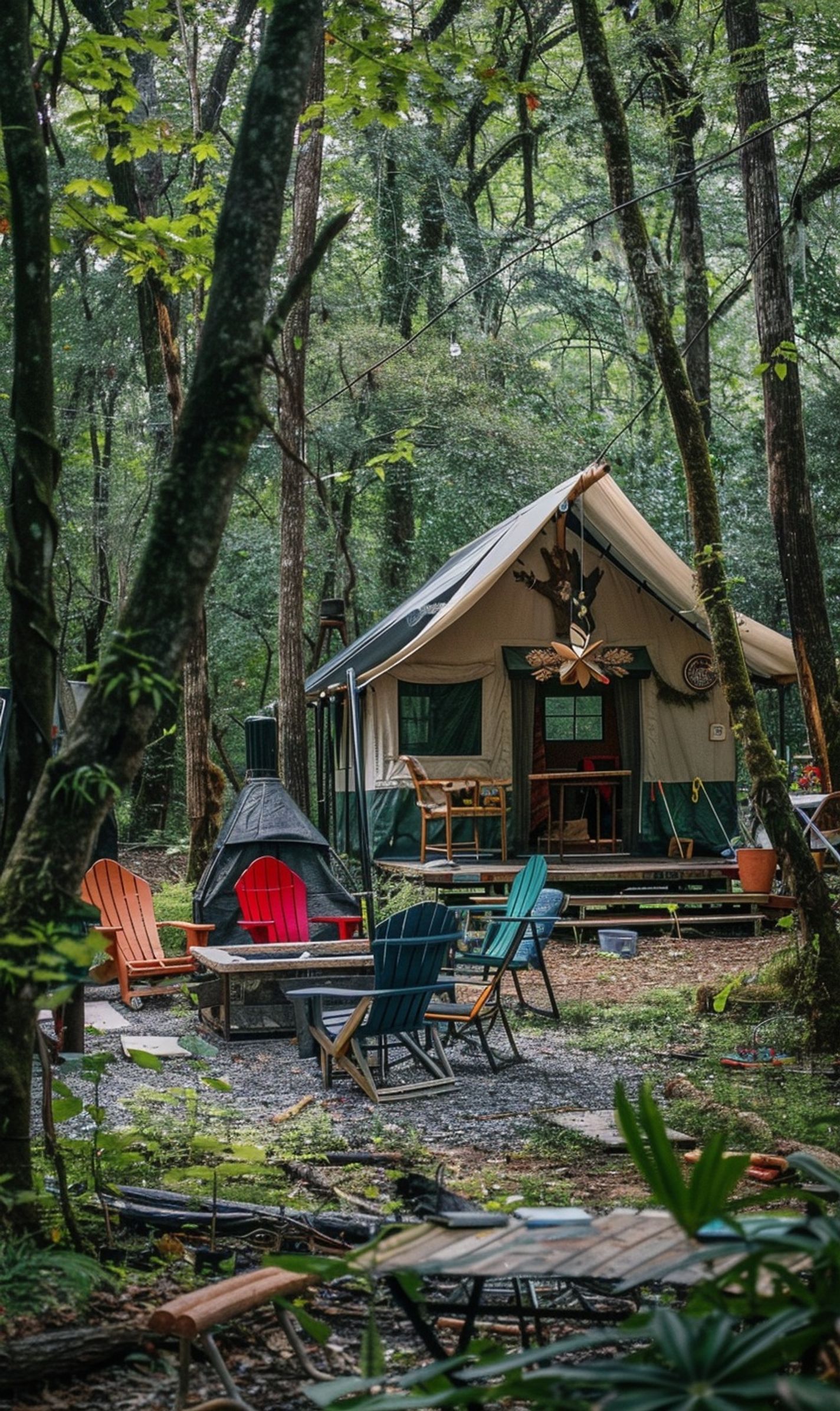
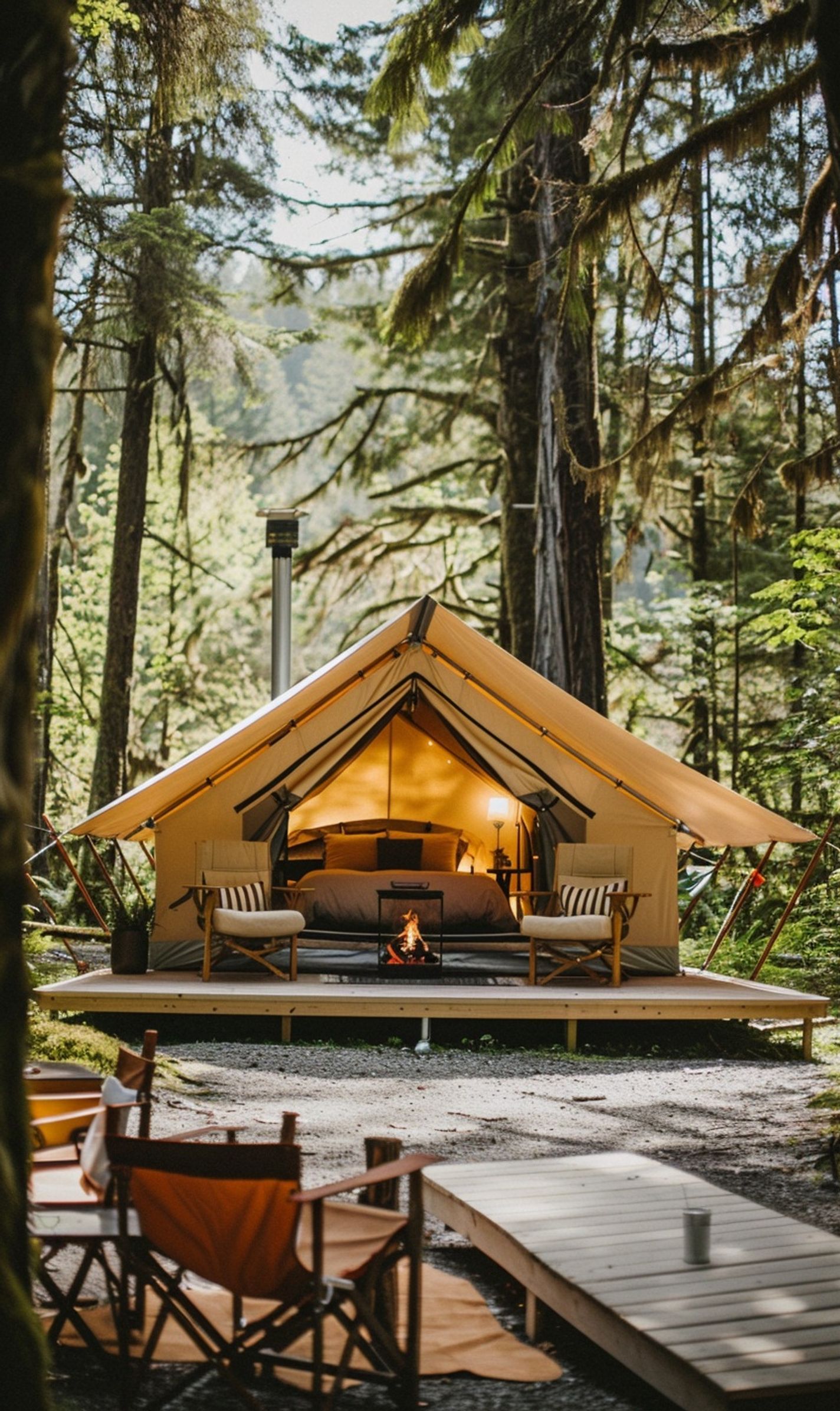
Frequently Asked Questions (FAQs)
What is an eco-friendly campsite organization?
Eco-friendly campsite organization involves practices that minimize camping’s impact on the environment, such as reducing waste, using sustainable materials, and respecting nature.
How can I practice sustainable camping at my campsite?
You can practice sustainable camping by using reusable camping gear, minimizing plastic usage, disposing of waste properly, and leaving no trace behind.
What are some eco-friendly campsite organization tips?
Some tips include using solar-powered lights, packing reusable utensils and containers, choosing biodegradable soaps, and opting for eco-friendly insect repellents.
Why is it essential to organize a campsite sustainably?
Organizing a campsite sustainably helps preserve the natural environment, reduce pollution, protect wildlife, and ensure future generations can enjoy the outdoors.
How can I reduce waste while camping?
You can reduce waste by packing food in reusable containers, avoiding single-use plastics, using cloth towels instead of paper, and practicing proper recycling.
What are some sustainable practices for outdoor living?
Sustainable outdoor practices include choosing eco-friendly camping locations, respecting wildlife and plant life, conserving water, and using alternative energy sources.







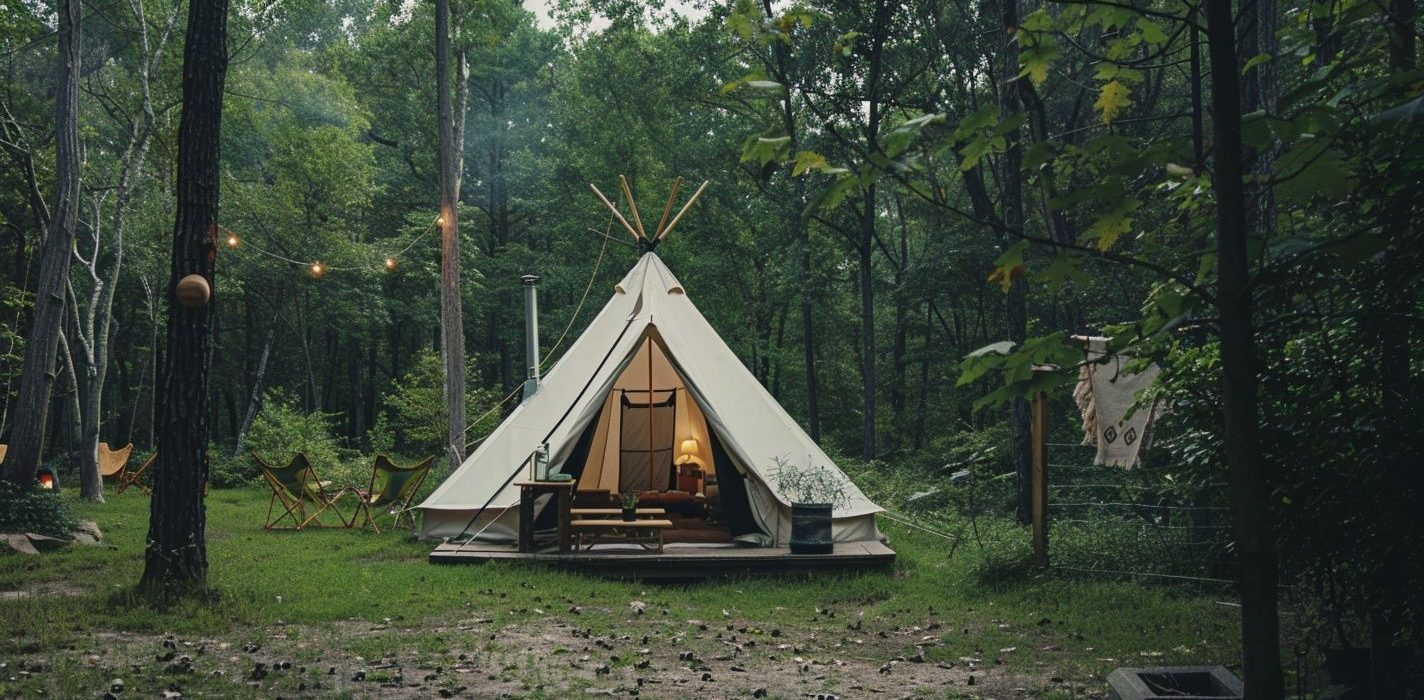


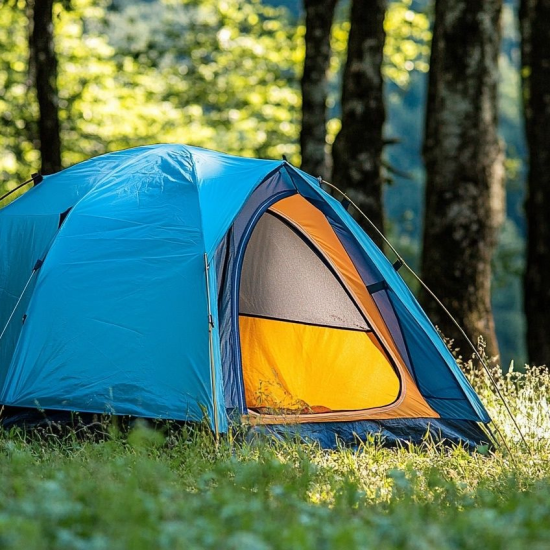
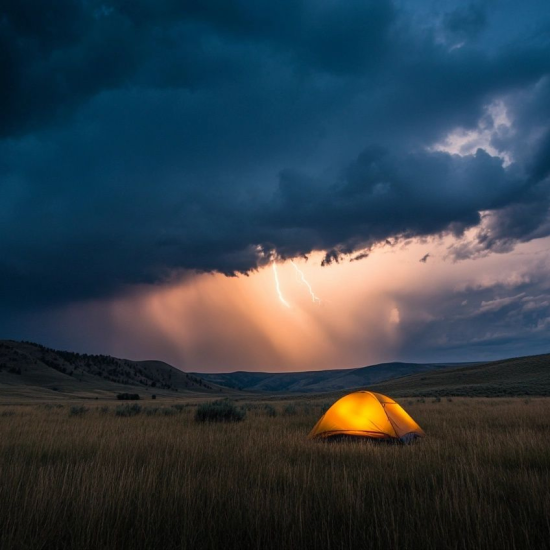
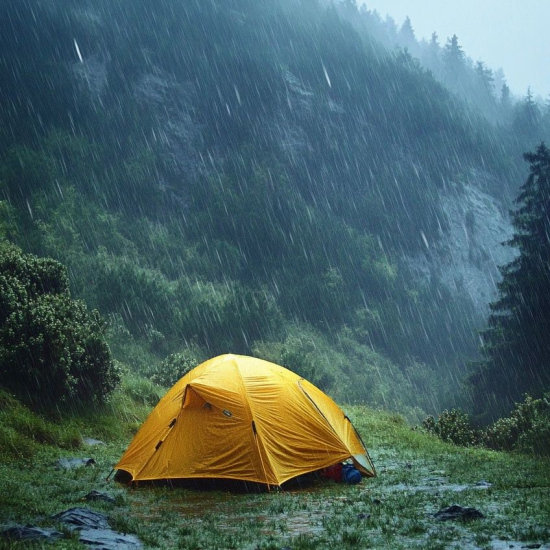
No Comment! Be the first one.